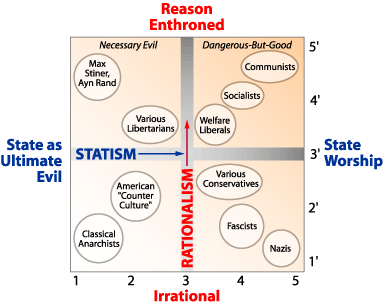Pournelle chart

The Pournelle chart, developed by Jerry Pournelle (in his 1963 political science Ph.D. dissertation), is a two-dimensional coordinate system which can be used to distinguish political ideologies. It is similar to the Political Compass and the Nolan Chart in that it is a two-dimensional chart, but the axes of the Pournelle chart are different from those of other systems.
The two axes are as follows:
- The x-axis, "Attitude toward the State" (labeled statism), refers to a political philosophy's attitude toward the state and centralized government. The farthest right is "state worship," and the farthest left represents the state as the "ultimate evil," preferring individual freedom.
- The y-axis, "Attitude toward planned social progress" (labeled rationalism), refers to the extent which a political philosophy is compatible with the idea that social problems can be solved by use of reason. The top indicates complete confidence in planned social progress; the bottom represents skepticism of such methods, often considering them as naively utopian. Those at the top of this axis would tend to discard a traditional custom if they do not understand what purpose it serves (considering it antiquated and probably useless), while those at the bottom would tend to keep the custom (considering it time-tested and probably useful).
Leftist ideologies, such as American liberalism, socialism and communism, are arranged by Pournelle in the upper right-hand quadrant of high state control and high rationalism. Conservatism, fascism, and Nazism are placed in the lower right hand quadrant of high state control and low rationalism. Classical anarchists are in the lower left hand corner of low state control and low rationalism. Libertarians (including anarcho-capitalists) and Objectivists are placed in the upper left-hand corner of low state control and high rationalism. Each diagonal axis contains "natural" political allies.
Criticisms
Some have criticized the model for the pejorative use of the word "irrational." However, the bottom of the scale could more specifically be seen as representing the belief that human rationality cannot perfect society. For example, the conservatism of Edmund Burke would be near the middle on the left-right scale but near the bottom on the "rationality" scale (3/1', in Pournelle-style notation), as Burke believed that human society was not perfectible, and he was skeptical about initiatives intended to improve society. Since Pournelle himself has opinions like those of Burke, it is clear that the term "irrational" is not intended as an insult.
Pournelle notes that the belief that all societal problems can be solved rationally may not itself be rational. It may similarly be argued that the bottom of the top-bottom spectrum represents a rejection not of reason's power to solve scientific/technical problems (Pournelle is a technology enthusiast) but of its utility in forming the community and determining its sense of fundamental purpose.
In fact, Pournelle himself uses the terms "rationalism" and "anti-rationalism," not "rational" and "irrational." The webpage "The Pournelle Political Axes" makes that clear.
See also
External links
- The Pournelle Political Axes
- Ambidextrous Sovereignty at the Wayback Machine (archive index)